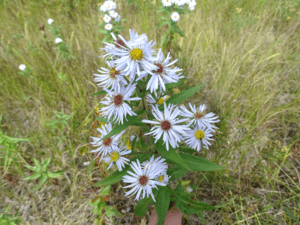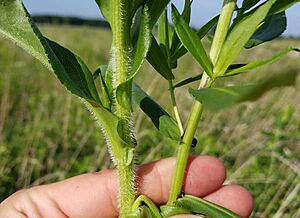Symphyotrichum firmum facts for kids
Quick facts for kids Symphyotrichum firmum |
|
|---|---|
 |
|
| In Ontario, Canada | |
| Conservation status | |
| Scientific classification |
The Symphyotrichum firmum, also called the shining aster or smooth swamp aster, is a type of plant that lives for many years. It's found naturally in Canada and the United States. This plant was once known as Aster firmus.
Contents
What Does the Shining Aster Look Like?
The shining aster can grow quite tall, up to 2 m (6 ft 7 in) (about 6.5 feet). It often grows in big groups. This plant spreads using long, underground stems called rhizomes. These rhizomes help new plants sprout up nearby.
Its main stem usually has no hair, or just a few short, stiff hairs in lines. Sometimes, the stem can be dark red or purple where the leaves attach. The leaves grow one after another along the stem. They can be up to 15 cm (5.9 in) (6 inches) long and 3 cm (1.2 in) (1 inch) wide. They wrap around the stem a little bit. The main vein on the underside of the leaf is usually smooth or has very few hairs.
Flowers of the Shining Aster
This plant blooms from August to October. Its flowers are about 1.5 to 3.5 cm (0.59 to 1.38 in) (0.6 to 1.4 inches) wide. Each flower head has two types of tiny flowers:
- Up to 40 ray florets: These are the petal-like parts around the edge. They can be white, light blue, or lavender.
- Up to 50 disc florets: These are the tiny flowers in the center. They start yellow or cream-colored and turn pink or purple as they get older.
The shining aster looks a lot like another plant called Symphyotrichum puniceum (purple-stemmed aster). However, S. firmum usually has less hair overall. Its flowers are often smaller and whiter, and they grow closer together. Also, S. firmum tends to form larger, thicker patches.
Where Does the Shining Aster Grow?
It can be a bit tricky to know exactly where the shining aster grows because it looks so much like S. puniceum. But we know it's found in many places:
- In Canada, it has been seen from Alberta all the way to Quebec.
- In the United States, it grows in the Midwest, parts of the Northeast, and in the Appalachian Mountains down to Georgia.
This plant prefers wet, sunny places. You might find it in fens (a type of wetland) or wet prairies (grassy areas). It often grows alongside S. puniceum. Unlike its close relative, the shining aster can sometimes spread into drier areas too.
Who Visits the Shining Aster?
Many different kinds of bees love to visit the flowers of the shining aster. They come to collect nectar and pollen. Some of the bees that have been seen on these flowers include:
- Agapostemon virescens
- Bombus species (bumblebees)
- Ceratina species (small carpenter bees)
- Halictus ligatus
- Melissodes druriella
How Is the Shining Aster Protected?
Organizations like NatureServe keep track of how common plants are. They say that the shining aster is generally "Secure" worldwide. This means it's not currently at high risk of disappearing.
However, in some specific places, it needs more protection:
- In North Carolina, it is "Critically Imperiled," meaning it's in great danger of disappearing there.
- In Quebec, it is "Vulnerable," meaning it could become endangered if things don't change.
- In New Jersey, it is "Presumed Extirpated," which means it's thought to have disappeared from that state.



